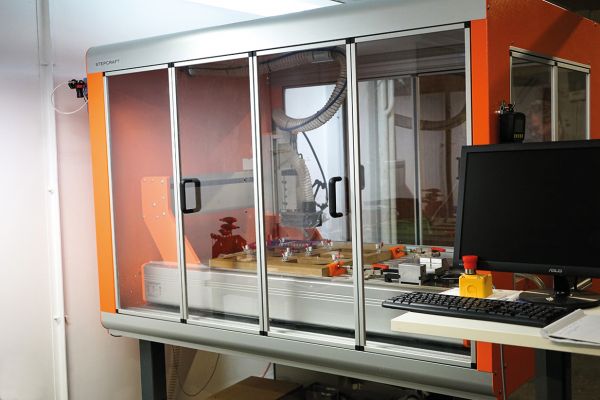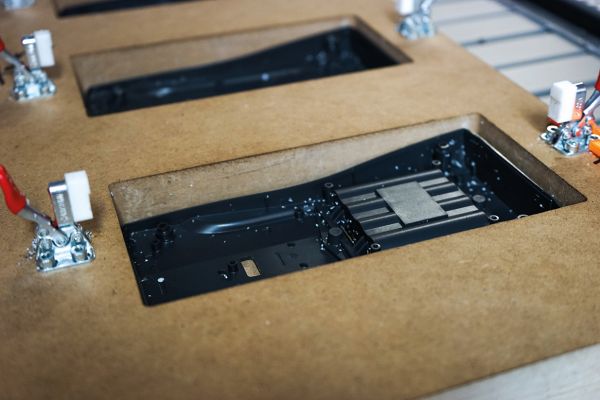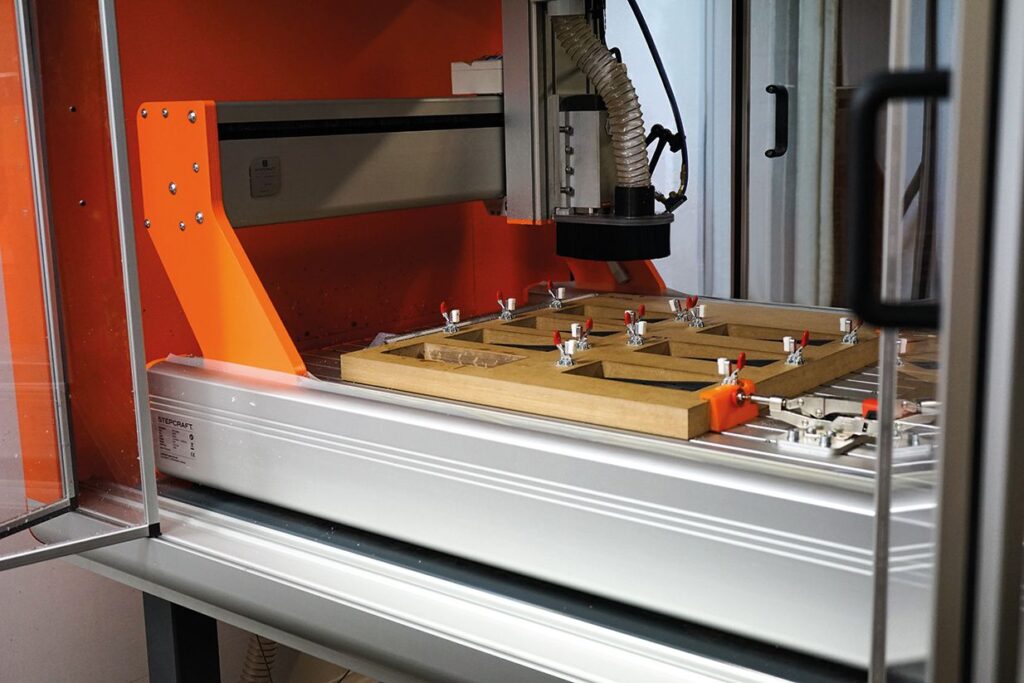MORE SPACE FOR EFFICIENCY
For many years, the Ansonic Funk- und Antriebstechnik GmbH has been relying on the CNC technology to industrially produce customized solutions.
Due to the STEPCRAFT Q.204, the company could drastically increase its efficiency and optimally position itself for future demands.
At an early stage, Ansonic specialized in the production of individual solutions. “Basically, we are practicing customized standard manufacture. This means that we standardly produce a specific article for a specific customer,” explains Dominik Pfaff, staff member of the electronic development at Ansonic. In order to mill the required holes for buttons into the housings of remote controls, the company made use of an old engraving machine at first. “The former housings were made of aluminum. Processing took extremely long and demanded high caution as the machine was just not designed for this application,” remembers the electronic engineer. Thus, it was soon concluded that a CNC machine should take over the milling tasks. As there did not exist knowledge regarding CNC technology in the company, Gerhard Ganser, one of the two managing directors at Ansonic, decided on teaching himself how to operate the machine and the respective software. As a trained mechanical engineer with subsequent studies of electronics, it did not take him long to get familiar with the concepts involved and from now on, a universal milling and drilling machine with self-fabricated CNC construction was applied for all milling operations. “

The technology came at a time when CNC got absolutely necessary if we wanted to continue to serve our customers. Otherwise, our products would not have been marketable anymore,” explains Gerhard Ganser. From now on, the main application of the CNC machine existed in the production of fixtures, the so-called trays. These are used at Ansonic to clamp the often unshapely electronic housings for further processing. This way, a housing does not have to be separately clamped into the steel vice anymore but can be fixed and processed simultaneously together with several others in a tray. “If a customer wants a specific button additionally, he will get it. With the CNC technology this is easily and quickly realizable. Anything else would involve considerable effort,” explains the managing director. Furthermore, the electronics that are located in the circuit board under the holes need to be triggered with an accuracy of one tenth of a millimeter. A precision that could not be achieved manually.

Although the new machine meant a considerable optimization of the manufacturing process, its limitation became apparent after only a couple of years. While the former CNC machine had a huge Z-height, it just possessed a small machine bed. “As we had no means to manufacture larger trays, we could only produce small ones. This led to a very high effort as we could therefore only clamp and process four housings at once. The trays simply did not offer more space,” says Dominik Pfaff. The small machine bed was also an obstacle when it came to manufacturing GRP adapter plates. Together with the steel vices, it would have had to be completely disassembled in order to enable the processing of GRP sheets. Due to these obstacles it is not surprising that the production of adapter plates was often dispensed with. “If we want to process sheet material, we urgently need a gantry milling machine with a bigger work space,” the team was certain and began with the evaluation of relevant providers.
“First of all, we took a look at the major manufacturers but were soon at mid five- to six-digit amounts. These companies build excellent machines but in regard to their price structure and advantages this would not have been a sensible invest for us,” remembers Gerhard Ganser. In the end, three local German manufacturers offering CNC machines up to 20’000 € were shortlisted. “This was our absolute limit and it could gladly be considerably less,” concedes the managing director. After all machines had been inspected on-site and a favorite became more and more apparent, Dominik Pfaff called the attention of his boss to STEPCRAFT and their, at that time, newly launched Q-Series. Shortly afterwards, they visited the manufacturer to experience the machine live and Gerhard Ganser determined: “In contrast to the other machines we evaluated, the Q-Series was considerably better at a lower price.” Thus, it was decided on the Q.204 with a corresponding milling motor and additional accessories. Not much later the machine was finally approved at the manufacturer‘s site and the respective test protocol as well as the test workpiece were handed out. Thanks to the OneTechTM quality label, the STEPCRAFT technician who assembled this specific machine is clearly visible for every employee at Ansonic, which makes the contact more personal and efficient in case of possible support requests.
Since its successful commissioning the Q.204 has been in daily operation. “Thanks to the great workspace, we can now install our trays, the vacuum table and the steel vice all at the same time. This facilitates our work immensely,” rejoices Dominik Pfaff and continues: “In the past it was always ‚either … or‘. Today, we just quickly clamp the sheet, mill it and are already finished – this would simply not have been possible before.” Due to the size of the machine bed, the company is now able to choose the optimal clamping method for the respective workpiece, thus, reducing the changeover time close to zero. After homing and moving to the workpiece zero point, the milling job can be directly started. Instead of the former four remote controls, the company can now process 15 of these simultaneously in only 20 minutes. “We could not have realized these volumes before. Milling a remote control for two hours like before would be inconceivable today,” remarks the electronic engineer.

Not only the mechanical processing of the workpieces has changed, but also the design. While Ansonic previously used a simple 2,5D software to create the G code, the company relies on Fusion 360 from Autodesk today. The powerful CAD software features a fully integrated CAM process as well as an ever-expanding range of functions. “With Fusion 360 I can create real 3D designs in a relatively easy way at a very reasonable monthly contribution,” describes the managing director enthusiastically.
Thanks to up-to-date CNC technology and Fusion 360, the current manufacturing process proves highly efficient and more comfortable than ever before. This enables Ansonic to continue producing innovative, customized solutions internally and to quickly and easily implement customer wishes.
